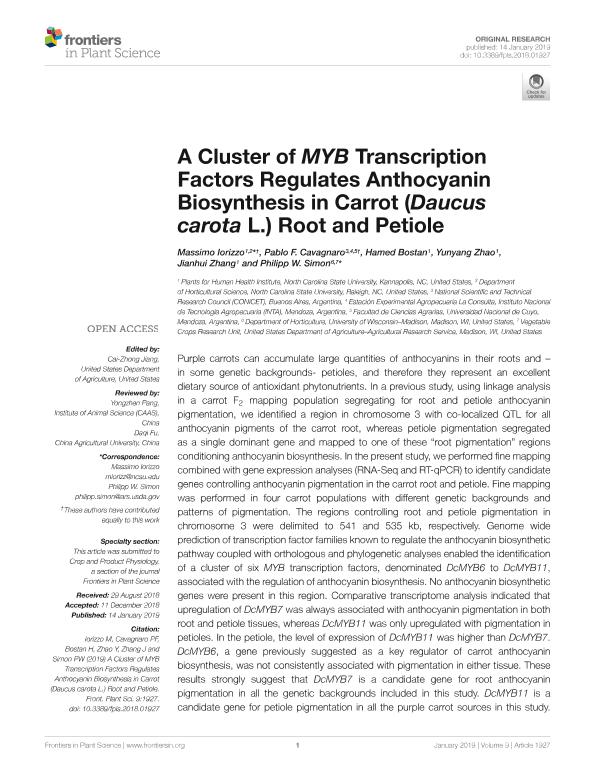Mostrar el registro sencillo del ítem
dc.contributor.author
Iorizzo, Massimo

dc.contributor.author
Cavagnaro, Pablo Federico

dc.contributor.author
Bolstan, Hamed
dc.contributor.author
Zhao, Yunyang
dc.contributor.author
Zhang, Jianhui
dc.contributor.author
Simon, Philipp W.
dc.date.available
2021-02-03T17:12:24Z
dc.date.issued
2019-01-14
dc.identifier.citation
Iorizzo, Massimo; Cavagnaro, Pablo Federico; Bolstan, Hamed; Zhao, Yunyang; Zhang, Jianhui; et al.; A cluster of MYB transcription factors regulates anthocyanin biosynthesis in carrot (Daucus carota L.) root and petiole; Frontiers Media S.A.; Frontiers in Plant Science; 9; 1927; 14-1-2019; 1-16
dc.identifier.uri
http://hdl.handle.net/11336/124624
dc.description.abstract
Purple carrots can accumulate large quantities of anthocyanins in their roots and – in some genetic backgrounds-petioles, and therefore they represent an excellent dietary source of antioxidant phytonutrients. In a previous study, using linkage analysis in a carrot F 2 mapping population segregating for root and petiole anthocyanin pigmentation, we identified a region in chromosome 3 with co-localized QTL for all anthocyanin pigments of the carrot root, whereas petiole pigmentation segregated as a single dominant gene and mapped to one of these “root pigmentation” regions conditioning anthocyanin biosynthesis. In the present study, we performed fine mapping combined with gene expression analyses (RNA-Seq and RT-qPCR) to identify candidate genes controlling anthocyanin pigmentation in the carrot root and petiole. Fine mapping was performed in four carrot populations with different genetic backgrounds and patterns of pigmentation. The regions controlling root and petiole pigmentation in chromosome 3 were delimited to 541 and 535 kb, respectively. Genome wide prediction of transcription factor families known to regulate the anthocyanin biosynthetic pathway coupled with orthologous and phylogenetic analyses enabled the identification of a cluster of six MYB transcription factors, denominated DcMYB6 to DcMYB11, associated with the regulation of anthocyanin biosynthesis. No anthocyanin biosynthetic genes were present in this region. Comparative transcriptome analysis indicated that upregulation of DcMYB7 was always associated with anthocyanin pigmentation in both root and petiole tissues, whereas DcMYB11 was only upregulated with pigmentation in petioles. In the petiole, the level of expression of DcMYB11 was higher than DcMYB7. DcMYB6, a gene previously suggested as a key regulator of carrot anthocyanin biosynthesis, was not consistently associated with pigmentation in either tissue. These results strongly suggest that DcMYB7 is a candidate gene for root anthocyanin pigmentation in all the genetic backgrounds included in this study. DcMYB11 is a candidate gene for petiole pigmentation in all the purple carrot sources in this study. Since DcMYB7 is co-expressed with DcMYB11 in purple petioles, the latter gene may act also as a co-regulator of anthocyanin pigmentation in the petioles. This study provides linkage-mapping and functional evidence for the candidacy of these genes for the regulation of carrot anthocyanin biosynthesis.
dc.format
application/pdf
dc.language.iso
eng
dc.publisher
Frontiers Media S.A.

dc.rights
info:eu-repo/semantics/openAccess
dc.rights.uri
https://creativecommons.org/licenses/by-nc-sa/2.5/ar/
dc.subject
ANTHOCYANIN ACCUMULATION
dc.subject
CANDIDATE GENES
dc.subject
DAUCUS CAROTA L.
dc.subject
FINE MAPPING
dc.subject
REGULATION
dc.subject
ROOT AND PETIOLE
dc.subject
TRANSCRIPTOME
dc.subject.classification
Horticultura, Viticultura

dc.subject.classification
Agricultura, Silvicultura y Pesca

dc.subject.classification
CIENCIAS AGRÍCOLAS

dc.title
A cluster of MYB transcription factors regulates anthocyanin biosynthesis in carrot (Daucus carota L.) root and petiole
dc.type
info:eu-repo/semantics/article
dc.type
info:ar-repo/semantics/artículo
dc.type
info:eu-repo/semantics/publishedVersion
dc.date.updated
2020-11-18T16:42:19Z
dc.identifier.eissn
1664-462X
dc.journal.volume
9
dc.journal.number
1927
dc.journal.pagination
1-16
dc.journal.pais
Suiza

dc.journal.ciudad
Lausanne
dc.description.fil
Fil: Iorizzo, Massimo. North Carolina State University. Department Of Food, Bioprocessing And Nutrition Sciences. Plants For Human Health Institute; Estados Unidos
dc.description.fil
Fil: Cavagnaro, Pablo Federico. Instituto Nacional de Tecnología Agropecuaria. Centro Regional Mendoza-San Juan. Estación Experimental Agropecuaria La Consulta; Argentina. Consejo Nacional de Investigaciones Científicas y Técnicas; Argentina. Universidad Nacional de Cuyo. Facultad de Ciencias Agrarias. Departamento de Producción Agropecuaria. Cátedra de Horticultura y Floricultura; Argentina
dc.description.fil
Fil: Bolstan, Hamed. North Carolina State University. Department Of Food, Bioprocessing And Nutrition Sciences. Plants For Human Health Institute; Estados Unidos
dc.description.fil
Fil: Zhao, Yunyang. North Carolina State University. Department Of Food, Bioprocessing And Nutrition Sciences. Plants For Human Health Institute; Estados Unidos
dc.description.fil
Fil: Zhang, Jianhui. North Carolina State University. Department Of Food, Bioprocessing And Nutrition Sciences. Plants For Human Health Institute; Estados Unidos
dc.description.fil
Fil: Simon, Philipp W.. United States Department of Agriculture. Agricultural Research Service; Argentina. University of Wisconsin; Estados Unidos
dc.journal.title
Frontiers in Plant Science
dc.relation.alternativeid
info:eu-repo/semantics/altIdentifier/url/https://www.frontiersin.org/articles/10.3389/fpls.2018.01927
dc.relation.alternativeid
info:eu-repo/semantics/altIdentifier/doi/http://dx.doi.org/10.3389/fpls.2018.01927
Archivos asociados
